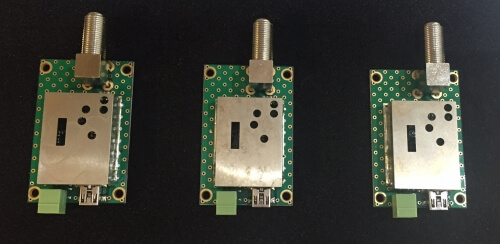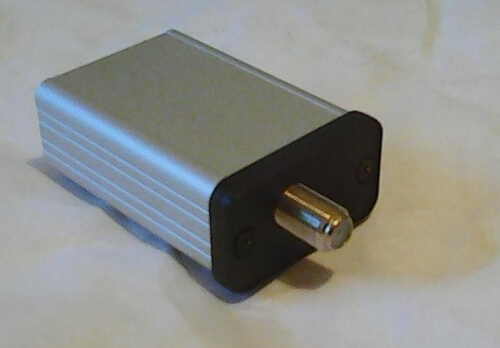New ThumbNet RTL-SDR Receiver Released: F-Connector, TCXO, External DC Power, No Switch-Mode Power
ThumbSat is a company that aims to help experimenters design and launch experiments on their mini satellites (10x smaller than a regular cubesat with most of the same functionality) into orbit. They write that for about $20k they will fully design a satellite based experiment and launch it into orbit – all you need to do is provide the orbital experiment that you would like done.
To aide with the reception, they also have the ThumbNet project which aims to setup a network of satellite receivers around the world. They do this by providing school students around the world with low cost satellite receivers. The satellite receivers consist of modified/upgraded RTL-SDR dongles and satellite antennas.
Today the ThumbNet project announced the latest iteration of their RTL-SDR dongle, called the ThumbNet N3 SDR Receiver. This receiver has some interesting design changes when compared to any other dongle that we’ve seen so far. The biggest change appears to be that this dongle uses an external power port for power. They also replaced the 1.2V switching regulator with a 1.2V linear regulator for lower noise operation. This is useful because switching regulators can cause noise, whilst linear regulators are much cleaner. However, using a linear regulator increases the power consumption significantly, and the new dongle draws 450mA of current (vs 250-280 mA on standard or our V3 dongles), meaning that some USB ports may be unable to power the device unless the external power supply port is used.
The other interesting change is that they have changed the PCB form factor, and it can now fit into a common 1455 aluminum case. Also, similarly to our V3 RTL-SDR dongles, they have decided to add a common mode choke to the USB lines, which significantly reduces USB noise. To add ESD protection they also added a static bleed resistor. Finally, like their previous receivers they continue to use a F-type RF connector and a TCXO for frequency stability.
The price is $25.75 each plus flat rate global shipping of $4.50 and the receivers are expected to ship in mid-October. While we have not yet tested this model, it looks to be like a good receiver for those who need very low noise, or external power options.
They write:
The next Generation, ThumbNet N3 is designed from the ground up to be as simple to use as older generation dongles, but with powerful hardware features for advanced hobbyists and experimenters.
We removed all of the excess components that were sources of noise or interference in other dongles, and optimized the circuit for simplicity, sensitivity and selectability. Then we added a port to use a cable with the extremely common mini-USB connection so that the N3 is less prone to noise from the host computer than a traditional dongle. Finally, the use of standard Surface Mount 0603 or larger components makes it simple for testing or modification.
We built them for our own use, then decided to offer them to everyone.
A quick list of the features of the N3:
– Full backward compatibility with existing RTL-SDR dongles and software
– High stability TCXO (+/-0.5ppm) (ensuring rock-solid stability from start-up and over a wide range of temperatures)
– Standard R820T2 + RTL2832U (plus 24C02 EEPROM) chipset
– Improved/enhanced decoupling. (Common-mode choke on USB port)
– Low-noise, linear only power regulation (separate 1.2v and 3.3v regulators)
– External DC (+5v, 450mA) supply connector
– Mini-USB connection (allows easy separation of the RF unit from the noisy PC)
– F type RF connector (very common and compatible with existing ThumbNet tracking stations)
– Large (6x4cm) contiguous ground-plane (for better thermal dissipation)
– Static drain-away resistor on the RF input (1K to ground)
– All unnecessary parts (IR receiver, high-current LED etc.) eliminated to reduce parts count and noise
– Circuit board can be mounted into a common 1455 caseIdeal for experimentation:
– Can be connected to an external power supply for very clean power
– All of the important tracks are visible on the top side of the board for easy access
– All of the RF parts are on the top of the board (only regulators and decouplers on the back)
– Logical, simple layout using 0603 (or larger) SMT parts
– IF port break in connector (between front end and IF/USB chip) providedWhile not required for operation, the N3 receiver is designed to be able to utilize a clean source of power from an external 5v power supply, instead of using the noisy power line coming from the computer’s USB port. This gives a tremendous advantage to the purist or experimenter who wants to utilize power from the N3 to power any external experiments. (When the external power supply is active, no power is drawn from the USB port to power the N3.)
PLEASE NOTE: The N3 draws approximately 450mA of current and care should be taken, even when using a powered USB hub, as it could possibly exceed the current limit of the USB port.


Looks nice I will try it. Why F connector though ???
I am very interested in the bare board model allowing access to components and traces, however I can’t find a component layout or circuit diagram anywhere on the website – will these be made available???
The enclosure is possibly the 1455D601.
Is 450 mA currect draw normal for a RTL USB dongle? Does anybody know what current the RTL-SDR V2 or V3 draws, just to make a comparison?
The ThumbNet dongle draws 450mA of current vs 250-280 mA on standard or our V3 dongles.
Thanks. Do you know what circuit is responsible for the extra 170 to 200 mA?
Isn’t everything written clearly in the article?
A linear regulator wastes more power compared to a switching regulator which is used by default in the regular dongles. But linear regulators are less noisy.
> for about $20k they will fully design a satellite based experiment and launch it into orbit
If that includes EM drive & solar power supply I am ready to buy
https://www.youtube.com/channel/UCm54FS3u2aDeutnMsV0cITg/videos
Has a satellite ever flown an SDR for the purpose of quantifying radio spectrum usage?
Granted, most terrestrial antennas are designed to transmit most of their signal toward the horizon and not up, so it might be hard to accurately triangulate sources. Moreover propagation effects might skew the results (at HF because of “skip” and at VHF/UHF because of ducting events) But at least in a rough way, it might be interesting to see how band activity varies from country to country, in near-real-time.
What are the rf specs? Freq range, bandwidth, dynamic range? It would be really nice to have these listed. What is the marketing team doing?
Is this thumbnet sdr only good for satellites Rx usage? or good for “regular” frequency too?
I do not have any sdr so wonder getting one.
Sounds like you want to buy a sports car with a manual transmission so you can learn how to shift.
There are lots of ‘cheaper ones’ available today, that’ll do 95% of the one above…
with a ‘bang for buck’ ratio that can’t be beat.
I have a couple of 12 bit SDRs and they are NOT 5 times better than my rtl-sdr rxes/
nesdr smarts.
In a linear scale 12bit like 16 times better than 8bit.
Each bit you add increases your dynamic range by 6 db. So a 12 bit A/D converter has 24 db more range than an 8 bit converter.
Pretty much any SDR can be used for either terrestrial or satellite, with the following caveats:
* Although the radio itself doesn’t matter much, the antenna design matters tremendously. Most radio hobbyists will probably own about two or three different antennas for each radio they own.
* Satellite systems generally benefit from low noise figures (both in receiver and especially any LNA) since they are receiving relatively weak signals from “cold” outer space. This same point also applies to terrestrial weak signal, but most people listening to terrestrial sources (police, fire, local ham radio chatter, etc.) are going to be listening to signals that are not “weak signal.” Most terrestrial sources are pretty strong so long as you are line-of-sight… generally you extend your range by increasing the height of your antenna rather than the sensitivity of your receiver.